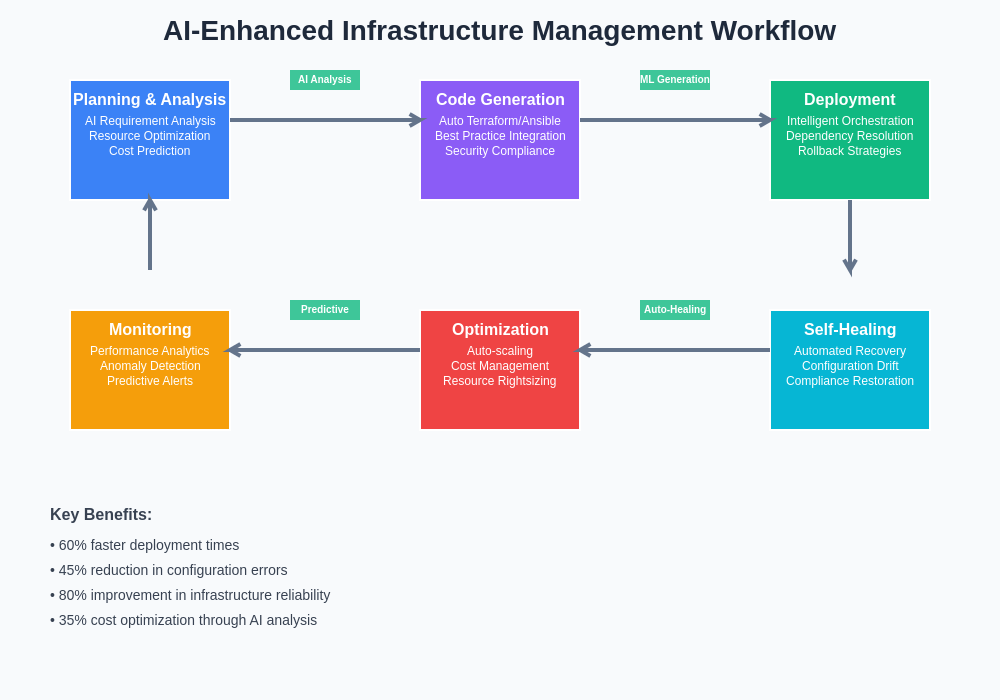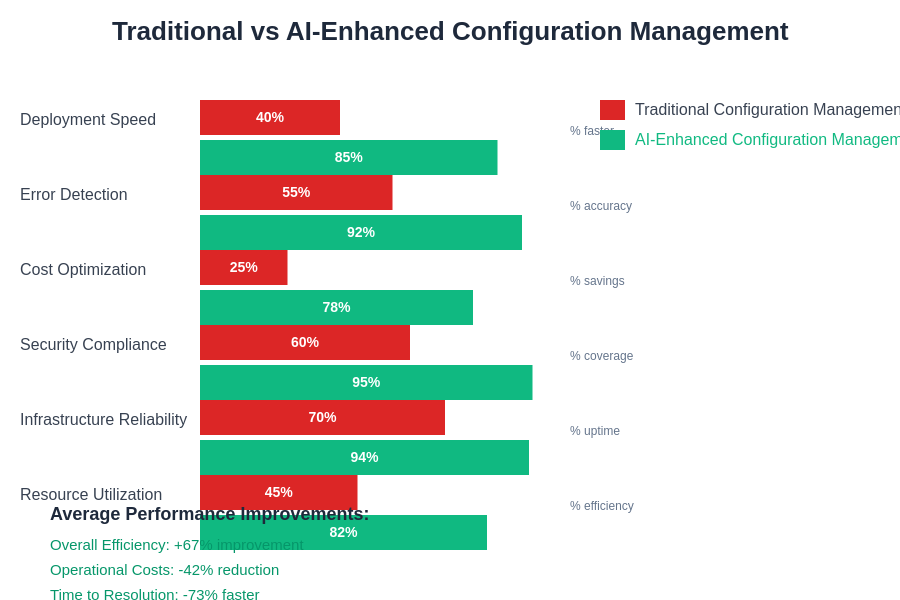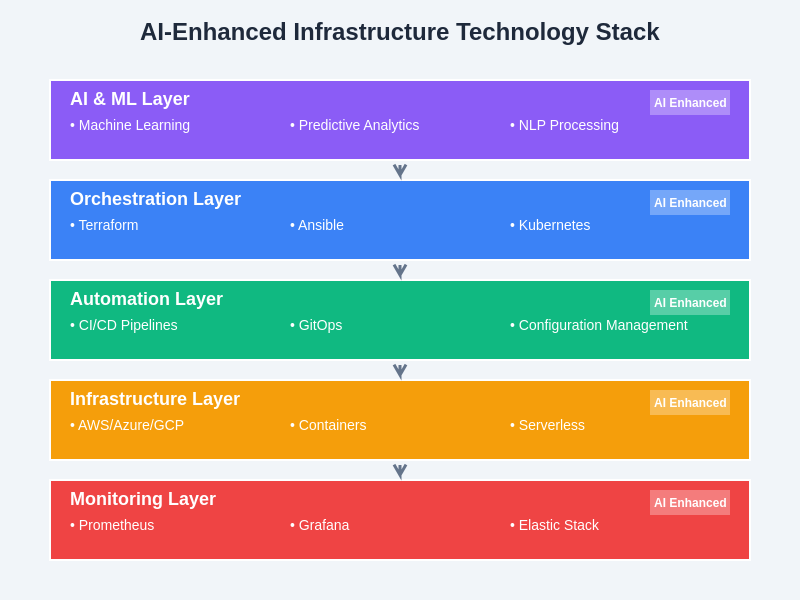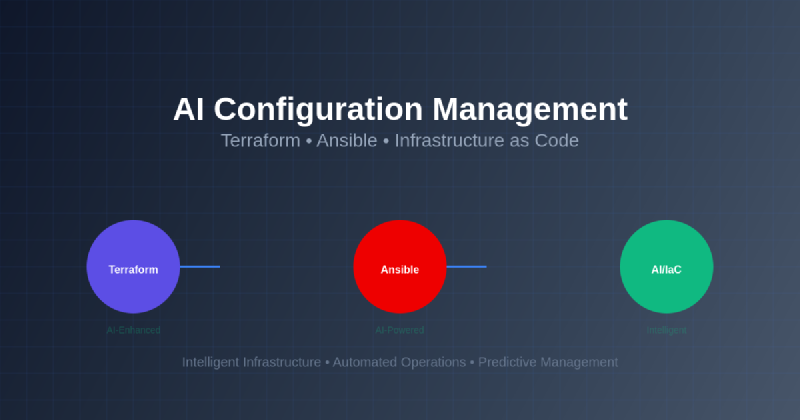The convergence of artificial intelligence and infrastructure management has ushered in a revolutionary era of intelligent configuration management, fundamentally transforming how organizations design, deploy, and maintain their technological infrastructure. Through the integration of AI capabilities with established tools like Terraform and Ansible, Infrastructure as Code has evolved from simple automation to sophisticated, self-optimizing systems that can predict, adapt, and resolve infrastructure challenges with unprecedented efficiency and accuracy.
Stay updated with the latest AI infrastructure trends as the landscape of intelligent operations continues to evolve at an accelerating pace. The marriage of artificial intelligence with traditional DevOps practices represents a paradigm shift that extends far beyond simple automation, creating intelligent systems capable of learning from operational patterns, predicting potential issues, and automatically implementing optimal solutions across complex multi-cloud environments.
The Evolution of Infrastructure Management
Traditional infrastructure management relied heavily on manual processes, static configurations, and reactive approaches to system administration that often resulted in inconsistent deployments, configuration drift, and prolonged downtime during maintenance windows. The introduction of Infrastructure as Code principles through tools like Terraform and Ansible marked the first major evolution, enabling organizations to codify their infrastructure requirements and achieve consistent, repeatable deployments across different environments.
The integration of artificial intelligence into this ecosystem represents the next evolutionary leap, transforming static configuration management into dynamic, intelligent systems that can analyze vast amounts of operational data, identify optimization opportunities, and implement changes autonomously. This AI-enhanced approach to infrastructure management enables organizations to achieve levels of operational efficiency, reliability, and scalability that were previously impossible with traditional methods.
Modern AI-powered configuration management systems can analyze historical deployment patterns, predict resource requirements, optimize cost allocation, and even prevent potential security vulnerabilities before they manifest in production environments. This proactive approach to infrastructure management represents a fundamental shift from reactive problem-solving to predictive optimization, enabling organizations to maintain robust, efficient, and secure infrastructure at scale.
Terraform Enhanced with AI Intelligence
Terraform’s declarative approach to infrastructure provisioning has been significantly enhanced through AI integration, enabling intelligent resource planning, automated optimization, and predictive cost management that extends far beyond traditional state management capabilities. AI-powered Terraform implementations can analyze infrastructure requirements, suggest optimal resource configurations, and automatically adjust provisioning parameters based on historical usage patterns and performance metrics.
The integration of machine learning algorithms into Terraform workflows enables intelligent dependency resolution, automated resource rightsizing, and predictive scaling that can anticipate demand fluctuations before they impact application performance. These AI-enhanced capabilities transform Terraform from a simple provisioning tool into an intelligent infrastructure orchestrator capable of making sophisticated optimization decisions based on comprehensive analysis of operational data.
Explore advanced AI development tools like Claude to enhance your infrastructure automation workflows with intelligent reasoning and comprehensive analysis capabilities. AI-enhanced Terraform implementations can automatically detect configuration inconsistencies, suggest security improvements, and optimize resource allocation across multi-cloud environments while maintaining compliance with organizational policies and regulatory requirements.
Advanced AI integration enables Terraform to perform intelligent state management, automatically resolving conflicts, predicting potential drift scenarios, and implementing preventive measures to maintain infrastructure consistency. These capabilities significantly reduce the operational overhead associated with large-scale infrastructure management while improving reliability and reducing the risk of configuration-related outages.

The comprehensive workflow demonstrates how AI intelligence integrates seamlessly with traditional infrastructure management practices, creating a continuous cycle of optimization that spans from initial planning through ongoing maintenance and self-healing operations. This intelligent approach transforms reactive infrastructure management into a proactive, predictive system that anticipates and prevents issues before they impact operations.
Ansible Automation Powered by Machine Learning
Ansible’s agentless architecture and human-readable playbooks provide an ideal foundation for AI enhancement, enabling intelligent task orchestration, adaptive execution strategies, and self-healing automation that can respond dynamically to changing infrastructure conditions. Machine learning algorithms can analyze playbook execution patterns, identify optimization opportunities, and automatically adjust automation strategies to improve performance and reliability.
AI-powered Ansible implementations can learn from successful and failed automation runs, building comprehensive knowledge bases that inform future execution strategies and enable predictive problem resolution. This learning capability transforms Ansible from a simple automation tool into an intelligent orchestrator that can adapt its behavior based on environmental conditions, application requirements, and operational constraints.
The integration of natural language processing capabilities enables Ansible to interpret complex operational requirements, automatically generate appropriate playbooks, and translate business objectives into actionable automation tasks. This AI-enhanced approach significantly reduces the expertise barrier for infrastructure automation while improving the quality and consistency of automated operations across diverse technology stacks.
Intelligent Ansible implementations can perform real-time analysis of system state, automatically detecting drift conditions, and implementing corrective actions without human intervention. This self-healing capability ensures infrastructure consistency while reducing the operational burden associated with maintaining large-scale automated environments.
Infrastructure as Code Revolution
The transformation of Infrastructure as Code through AI integration has created intelligent systems capable of learning from deployment patterns, optimizing resource utilization, and automatically implementing best practices across complex multi-cloud environments. These AI-enhanced IaC systems can analyze infrastructure requirements, suggest optimal architectures, and implement changes with minimal human intervention while maintaining compliance and security standards.
AI-powered IaC platforms can perform comprehensive analysis of infrastructure codebases, identifying potential security vulnerabilities, performance bottlenecks, and cost optimization opportunities that might be overlooked during manual reviews. This intelligent analysis capability enables organizations to maintain high-quality infrastructure code while reducing the expertise requirements for effective infrastructure management.
The integration of machine learning algorithms enables IaC systems to learn from operational experiences, building comprehensive knowledge bases that inform future infrastructure decisions and enable predictive optimization strategies. This learning capability transforms static infrastructure definitions into dynamic, adaptive systems that can evolve based on changing requirements and operational conditions.
Leverage AI-powered research tools like Perplexity to stay informed about emerging infrastructure technologies and best practices that can enhance your IaC implementations. Intelligent IaC systems can automatically generate documentation, implement testing strategies, and maintain compliance with organizational policies while adapting to evolving business requirements and technological constraints.
Intelligent Resource Optimization
AI-driven resource optimization represents one of the most significant advantages of intelligent configuration management, enabling systems to analyze usage patterns, predict demand fluctuations, and automatically adjust resource allocation to optimize performance while minimizing costs. These optimization algorithms can consider multiple factors including application requirements, performance constraints, budget limitations, and compliance requirements to make sophisticated resource allocation decisions.
Machine learning models can analyze historical resource utilization data to identify trends, predict future requirements, and implement proactive scaling strategies that prevent performance degradation while avoiding over-provisioning. This predictive approach to resource management enables organizations to maintain optimal performance levels while significantly reducing infrastructure costs through intelligent resource allocation.
The integration of AI-powered cost optimization enables infrastructure systems to continuously analyze spending patterns, identify cost reduction opportunities, and automatically implement optimization strategies that maintain performance while reducing operational expenses. These intelligent cost management capabilities can result in substantial savings while improving overall infrastructure efficiency and reliability.
Advanced optimization algorithms can consider complex interdependencies between different infrastructure components, ensuring that optimization decisions do not negatively impact related systems or create unexpected bottlenecks. This holistic approach to infrastructure optimization enables organizations to achieve maximum efficiency while maintaining system reliability and performance standards.
Predictive Infrastructure Management
The implementation of predictive analytics in infrastructure management enables organizations to transition from reactive problem-solving to proactive optimization, identifying potential issues before they impact operations and implementing preventive measures that maintain system reliability. AI-powered predictive systems can analyze vast amounts of operational data to identify patterns that indicate emerging problems, enabling early intervention and problem prevention.
Predictive infrastructure management systems can analyze system metrics, application performance data, and user behavior patterns to forecast resource requirements, identify potential bottlenecks, and recommend optimization strategies that prevent performance degradation. This predictive capability enables organizations to maintain consistent service levels while optimizing resource utilization and reducing operational costs.
The integration of anomaly detection algorithms enables infrastructure systems to identify unusual patterns that might indicate security threats, system failures, or performance issues, automatically triggering appropriate response actions and alerting operations teams to potential problems. This intelligent monitoring capability significantly improves system reliability while reducing the time required to identify and resolve infrastructure issues.
Advanced predictive systems can model complex scenarios, simulate the impact of proposed changes, and recommend optimal implementation strategies that minimize risk while maximizing operational benefits. This simulation capability enables organizations to make informed infrastructure decisions while reducing the risk associated with system modifications and upgrades.
Security Integration and Compliance
AI-enhanced configuration management systems provide sophisticated security capabilities that can automatically identify vulnerabilities, implement security best practices, and maintain compliance with regulatory requirements across complex multi-cloud environments. These intelligent security systems can analyze configuration patterns, identify potential security risks, and automatically implement appropriate countermeasures without compromising system functionality.
Machine learning algorithms can analyze security threat intelligence, identify emerging attack vectors, and automatically update infrastructure configurations to protect against new vulnerabilities. This dynamic security approach ensures that infrastructure remains protected against evolving threats while maintaining operational efficiency and system performance.
The integration of compliance monitoring capabilities enables AI-powered systems to continuously audit infrastructure configurations, identify compliance violations, and automatically implement corrective actions that maintain regulatory compliance. This automated compliance management significantly reduces the operational burden associated with maintaining complex regulatory requirements while ensuring consistent adherence to security standards.
Intelligent security systems can perform comprehensive risk analysis, evaluating the security implications of proposed infrastructure changes and recommending modifications that maintain security while achieving operational objectives. This risk-aware approach to infrastructure management ensures that security considerations are integrated into all aspects of system design and implementation.
Multi-Cloud Intelligence
The complexity of multi-cloud environments requires sophisticated management capabilities that can optimize resource allocation, maintain consistency, and ensure seamless integration across different cloud platforms. AI-powered configuration management systems provide intelligent orchestration capabilities that can analyze the strengths and limitations of different cloud providers, automatically selecting optimal platforms for specific workloads and requirements.
Intelligent multi-cloud management systems can perform cost analysis across different providers, automatically migrating workloads to optimize expenses while maintaining performance requirements. This dynamic resource allocation capability enables organizations to leverage the best features of multiple cloud platforms while minimizing costs and complexity.
The integration of AI-powered network optimization enables multi-cloud systems to automatically configure connectivity, implement security policies, and optimize data transfer patterns to minimize latency and maximize performance. These intelligent networking capabilities ensure seamless integration between different cloud environments while maintaining security and performance standards.
Advanced multi-cloud intelligence can analyze application requirements, regulatory constraints, and performance objectives to recommend optimal deployment strategies that leverage the unique capabilities of different cloud platforms. This intelligent platform selection ensures that applications are deployed in environments that maximize performance while minimizing costs and complexity.
Automated Disaster Recovery and Resilience
AI-enhanced infrastructure systems provide sophisticated disaster recovery capabilities that can automatically detect failures, implement recovery procedures, and restore service with minimal downtime. These intelligent recovery systems can analyze failure patterns, predict potential disaster scenarios, and implement preventive measures that improve system resilience and reduce the impact of infrastructure failures.
Machine learning algorithms can analyze system dependencies, identify critical failure points, and automatically implement redundancy strategies that ensure service continuity even during major infrastructure disruptions. This intelligent resilience planning enables organizations to maintain high availability while optimizing resource utilization and reducing operational complexity.
The integration of automated testing capabilities enables AI-powered systems to continuously validate disaster recovery procedures, ensuring that recovery strategies remain effective as infrastructure evolves. This continuous validation approach ensures that disaster recovery capabilities remain reliable and effective while adapting to changing infrastructure requirements.
Intelligent disaster recovery systems can perform real-time analysis of system health, automatically detecting potential failure scenarios and implementing proactive measures that prevent service disruptions. This predictive approach to disaster recovery significantly improves system reliability while reducing the operational impact of infrastructure failures.
Performance Monitoring and Optimization
AI-powered performance monitoring systems provide comprehensive visibility into infrastructure behavior, automatically identifying performance bottlenecks, predicting capacity requirements, and implementing optimization strategies that maintain optimal system performance. These intelligent monitoring systems can analyze complex performance patterns, identify root causes of performance issues, and recommend targeted solutions that address specific problems without impacting overall system functionality.
Machine learning algorithms can establish baseline performance patterns, automatically detecting deviations that indicate potential problems and triggering appropriate response actions. This intelligent anomaly detection capability enables early identification of performance issues while reducing false alerts and operational noise that can overwhelm operations teams.
The integration of predictive performance analysis enables infrastructure systems to forecast performance trends, identify potential bottlenecks before they impact operations, and implement proactive optimization strategies that maintain consistent service levels. This predictive approach to performance management enables organizations to maintain high-quality user experiences while optimizing resource utilization and operational costs.
Advanced performance optimization systems can analyze the impact of different configuration changes, recommend optimal settings for specific workloads, and automatically implement performance improvements that enhance system efficiency. This intelligent optimization capability ensures that infrastructure configurations remain optimized for current requirements while adapting to changing operational conditions.
Cost Management and Financial Optimization
Intelligent cost management represents a critical capability of AI-enhanced infrastructure systems, enabling organizations to optimize spending while maintaining performance and reliability requirements. AI-powered cost optimization systems can analyze spending patterns, identify cost reduction opportunities, and automatically implement optimization strategies that minimize expenses without compromising system functionality.
Machine learning algorithms can predict cost trends, identify spending anomalies, and recommend budget allocation strategies that optimize resource utilization while maintaining operational requirements. This predictive cost management capability enables organizations to make informed financial decisions while avoiding unexpected expenses and budget overruns.
The integration of automated cost optimization enables infrastructure systems to continuously analyze resource utilization, identify underutilized resources, and implement rightsizing strategies that reduce costs while maintaining performance levels. This ongoing optimization ensures that infrastructure spending remains aligned with actual requirements while minimizing waste and inefficiency.
Advanced cost management systems can perform comprehensive financial analysis, evaluating the cost-effectiveness of different infrastructure strategies and recommending approaches that optimize total cost of ownership. This holistic financial perspective enables organizations to make strategic infrastructure decisions that balance immediate costs with long-term operational benefits.

The quantitative benefits of AI-enhanced configuration management are substantial across all critical metrics, demonstrating consistent improvements in operational efficiency, cost optimization, and system reliability. Organizations implementing AI-powered infrastructure management typically experience dramatic improvements in deployment speed, error reduction, and overall operational effectiveness.
Future Trends and Emerging Technologies
The future of AI-enhanced configuration management promises even more sophisticated capabilities, including autonomous infrastructure management, predictive optimization, and self-healing systems that can operate with minimal human intervention. Emerging technologies such as quantum computing, edge computing, and advanced machine learning algorithms will further enhance the intelligence and capabilities of infrastructure management systems.
The integration of advanced natural language processing will enable infrastructure systems to interpret complex requirements, automatically generate appropriate configurations, and translate business objectives into technical implementations. This capability will significantly reduce the expertise barrier for infrastructure management while improving the consistency and quality of infrastructure implementations.
The development of federated learning approaches will enable infrastructure systems to learn from collective experiences across different organizations and environments, building comprehensive knowledge bases that improve decision-making and optimization strategies. This collaborative learning approach will accelerate the advancement of intelligent infrastructure management while maintaining data privacy and security.
The evolution toward autonomous infrastructure management will enable systems to operate independently, making sophisticated decisions about resource allocation, security implementations, and performance optimization without requiring human intervention. This autonomous capability will transform infrastructure management from a labor-intensive activity into an intelligent, self-managing system that adapts continuously to changing requirements and conditions.
Implementation Strategies and Best Practices
Successful implementation of AI-enhanced configuration management requires careful planning, gradual adoption, and continuous optimization based on operational experience and changing requirements. Organizations should begin with pilot projects that demonstrate value while building expertise and confidence in AI-powered infrastructure management capabilities.
The integration of AI capabilities should be aligned with existing operational processes, ensuring that intelligent systems enhance rather than disrupt established workflows and procedures. This gradual integration approach enables organizations to realize immediate benefits while building toward more comprehensive AI-enhanced infrastructure management capabilities.
Training and skill development represent critical success factors for AI-enhanced infrastructure management, requiring investment in both technical capabilities and operational processes that support intelligent automation. Organizations should focus on developing hybrid skills that combine traditional infrastructure expertise with AI and machine learning knowledge.

The modern AI-enhanced infrastructure technology stack integrates artificial intelligence capabilities across every layer of the infrastructure management hierarchy, from foundational monitoring and infrastructure services through advanced machine learning and predictive analytics capabilities. This comprehensive integration ensures that AI intelligence is available at every level of the infrastructure management process.
Continuous monitoring and optimization of AI systems ensure that intelligent capabilities remain effective and aligned with organizational objectives. Regular assessment of AI performance, identification of improvement opportunities, and refinement of intelligent algorithms ensure that AI-enhanced infrastructure management continues to deliver value as requirements evolve.
The successful implementation of AI-enhanced configuration management represents a transformative opportunity for organizations to achieve unprecedented levels of operational efficiency, reliability, and scalability while reducing costs and complexity. By thoughtfully integrating artificial intelligence with established infrastructure management practices, organizations can create intelligent systems that adapt continuously to changing requirements while maintaining high standards of security, performance, and compliance.
Disclaimer
This article is provided for informational purposes only and does not constitute professional advice. The implementation of AI-enhanced infrastructure management systems involves complex technical considerations that may vary based on specific organizational requirements, regulatory constraints, and operational environments. Readers should conduct thorough evaluation and testing before implementing AI-powered infrastructure management solutions. The effectiveness of AI-enhanced configuration management may depend on various factors including data quality, system complexity, and organizational expertise levels.
